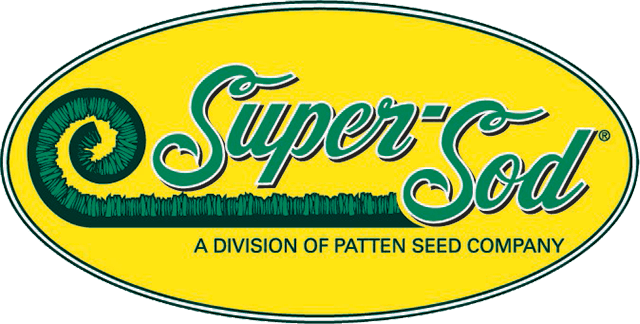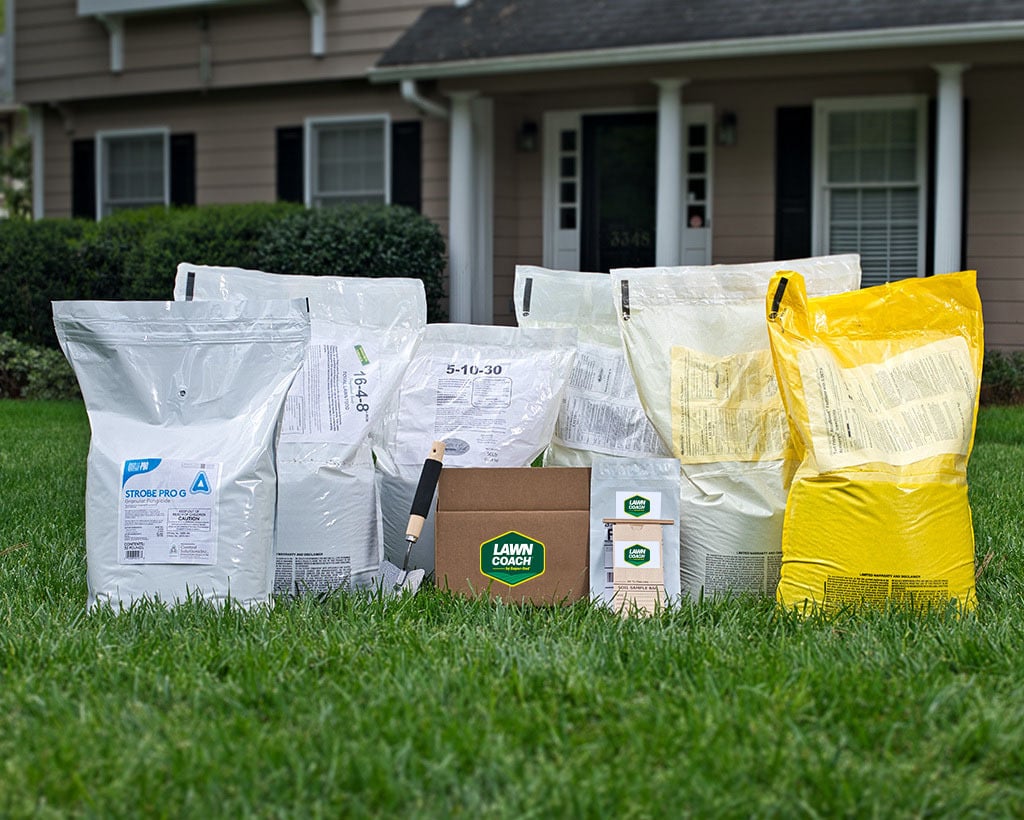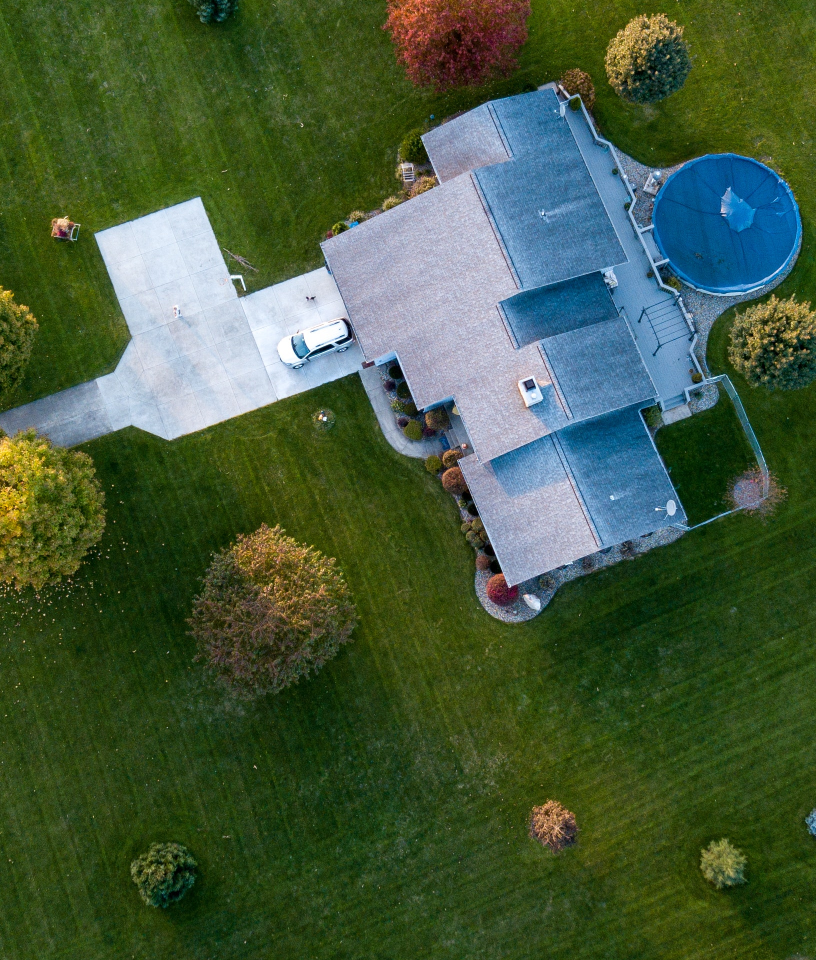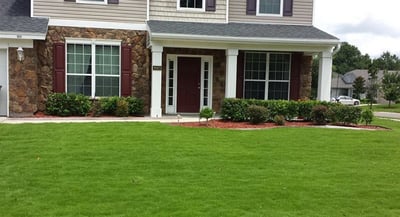
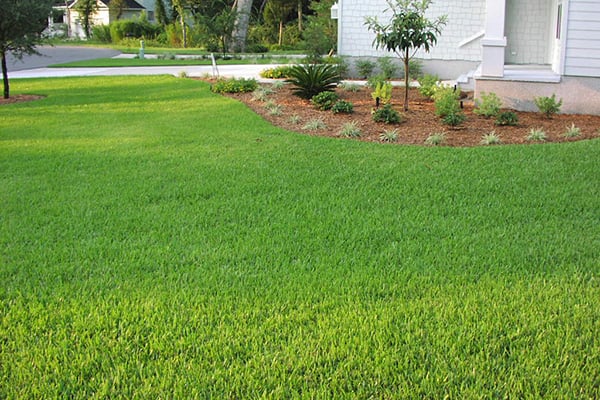
You've come to the right place to get the most out of your St. Augustine lawn. We'll cover the best lawn care practices to help St. Augustine lawns thrive. Use this lawn maintenance guide to keep your lawn green and resilient while understanding potential issues to look out for.
Bookmark this St. Augustine lawn care page, then subscribe to our Monthly Lawn Tips so we can email you lawn care tips and alerts.
Mowing a St. Augustine Lawn
- Mow with a rotary mower at 2 to 3.5" cut height.
- While St. Augustine is one of the most shade-tolerant lawns, it also grows well in full sun. Why do we mention this in the mowing section? If your lawn is not thriving in the shade, consider letting it grow a bit longer to 4" so there is more leaf blade to absorb more light. A little more light energy will help your lawn grow better in shade.
- Mow no more than 1/3 of the leaves off at one mowing. Use sharp mower blades and catch and remove clippings.
- For the most beautiful St. Augustine lawn, mow on a 7-to-10-day interval.
| Mow when grass is this tall: | 2.5 to 4" (up to 4.5" in shade) |
| Set cutting height of mower to: | 2 to 3.5" (up to 4" in shade) |
Watering St. Augustine Sod
St. Augustine performs best when it receives a whopping 2" of water per week. Keep in mind that St. Augustine's shallow roots make it susceptible to dying during prolonged droughts.
We recommend a slow, deep watering twice a week, rather than a little bit of watering every day.
Tips to Save Water:
- Water to supplement rainfall shortages only. If two or more inches of rainfall occur in a week, additional irrigation is not necessary. (Example: if 1.5" of rain occurs within a growing week, apply .5" of water by irrigation.)
- Avoid fixed timer irrigation settings that don't take into account weekly rainfall. Instead, use a rain gauge to monitor rainfall and turn your irrigation off/on accordingly.
- Do not waste water by overwatering; avoid run-off by watering in split applications. Likewise, avoid standing water for any period of time.
- Consider switching to drought-tolerant TifTuf Bermuda so you can turn off your irrigation. It has deep roots and will not die during typical Southern droughts.
Become a master at watering your lawn when you read our Watering Guides.
Fertilizing St. Augustine
- New Sod: New St. Augustine sod requires additional nutrition during its establishment phase, which our 18-24-12 Starter Fertilizer will provide.
- Established Sod: Apply between 2 and 4 pounds of nitrogen per 1000 square feet annually, during the growing season, according to the table below and based on feedback from a soil test.
- Select a fertilizer like ours that is labeled for use on St. Augustine grass lawns.
- Do not apply fertilizer to wet turf to avoid burning.
- Too much fertility will result in a thatchy, unhealthy lawn and increased disease risk.
- Don't fertilize with a high-nitrogen fertilizer in fall or winter when the lawn is going into dormancy or is dormant. Fertilize again in the spring only after full green up.
- Read about How to Calculate Fertilizer Rates.
- Supplemental iron will improve grass color. Super-Sod fertilizers already contain iron, so there are no additional iron products required.
- St. Augustine likes a pH between 6 and 6.5. Lime can safely be applied any time of year. Since not all soils need lime, apply it based on feedback from soil test recommendations.
Weed Control for St. Augustine Sod
St. Augustine's open growth can allow weeds to take root and for weed populations to grow. Follow these lawn care best practices for weed control:- Pre-emergent Herbicide: Use of a pre-emergent herbicide, recommended for use on St. Augustine lawns on the label, is strongly recommended in winter and fall. Apply pre-emergent weed control according to the table below.
- Post-emergent Herbicide: Apply post-emergent weed control to weeds you can see, as needed.
- Mowing: Regular mowing also reduces weeds by keeping them from going to seed and spreading.
Caution: Do not apply herbicides during high heat conditions - to avoid burning the lawn, it's best to apply herbicides in the morning or evening. St. Augustine is sensitive to some herbicides, so please read and follow all directions on the herbicide label. Make sure the herbicide label specifically says that it's safe for St. Augustine lawns.
We've compiled a master page of weed profiles to help you figure out the weeds you're seeing in your lawn. Enjoy browsing Weed Control for Lawns >>
Fertilizer & Pre-Emergent Herbicide Application Schedule
Look up Super-Sod's yellow spreader settings here.
Month |
Fertilizer & Weed Control (lbs/1000 sq.ft.) |
Timing |
| FEB | 0-0-7* + Iron w/ pre-emergent @ 6 lbs. | middle of month |
| MAY | 16-4-8 + Iron @ 6 lbs. | after full green up |
| JULY | 5-10-30 + Iron @ 5 lbs. | middle of month |
| AUG | 16-4-8 + Iron @ 6 lbs. | middle of month |
| OCT | 0-0-7* + Iron w/ pre-emergent @ 6 lbs. | first week |
| NOV | Muriate of Potash @ 1 lbs. | middle of month |
*Low nitrogen, so it's safe for the dormant season.
Insects & Diseases Concerns with St. Augustine
This section is heavy and is the disappointing aspect of choosing a St. Augustine lawn. Many insects and diseases love St. Augustine lawns as much as we humans do.
- Insects: Mole crickets, chinch bugs, sod webworms, and fall armyworms are common problems. Apply Talstar XTRA every July at 3.5 lbs. per 1,000 square feet to control these common insect infestations. Reapplication may be necessary.
- Various Viruses: St. Augustine Grass Decline (SAD) and gray leaf spot are viral diseases that commonly afflict St. Augustine lawns.
- Fungus Control: "Patch" diseases such as large patch (aka "brown patch") and take-all patch (aka "take all root rot") can be a problem. Due to our cold, wet winters, we recommend applying fungicide to St. Augustine lawns according to this schedule; however, it's hard to cure and prevent take-all patch. Replacement with a less disease-prone lawn may be necessary. We recommend our Zoysias and TifTuf Bermuda as replacements.
Month |
Fungicide |
Timing |
| JUNE | Professional fungicide | first week of month |
| OCT | Professional fungicide | middle of month |
Additional St. Augustine Maintenance
- Thatch Removal: Periodically, it may be necessary to remove accumulated thatch if you over-fertilize and don't bag your clippings. Because St. Augustine has such shallow roots, we suggest avoiding dethatching machines because they will tear up the roots too much.
Instead, dethatch small lawns with a rake and all lawns should be aerated with a core aerator. After aeration, topdress the lawn with Soil³ compost. The beneficial bacteria in compost aid in breaking down thatch. Read How and When to Aerate Your Lawn >>
Going forward, bag your clippings when you mow and put the clippings on your compost pile instead of leaving them on your lawn. - Cold Winters: If your St. Augustine doesn't come out of dormancy in the spring, it could simply be that cold weather killed it. This is nature's way of suggesting that you replace it with TifTuf Bermudagrass or one of our Zoysias.
